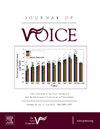声学-气动声音结果比率识别单侧声带麻痹声带内固定后声带功能的变化。
IF 2.4
4区 医学
Q1 AUDIOLOGY & SPEECH-LANGUAGE PATHOLOGY
引用次数: 0
摘要
目的:本研究旨在确定结合声学(输出)和空气动力学(输入)参数的基于比率的测量是否能检测单侧声带麻痹术后声带内化后的发声功能变化。方法:回顾性分析149例单侧声带麻痹患者术前和术后的声学和空气动力学指标。对传统发声效率(VE)、声压级与气动功率(SPL/AP)、SPL与平均气流(SPL/AFLOW)、,以及SPL与声门下压(SPL/Ps)-研究治疗阶段和响度水平(舒适度和音量)的主要影响和相互作用。除SPL/Ps外,治疗阶段和响度水平的主要影响在所有测量中都具有统计学意义。VE和SPL/AP存在交互作用,表明治疗效果的大小因响度而异。SPL/AFLOW在两种响度条件下都具有中等到大的效应大小。SPL/Ps的术后变化取决于AFLOW的减少程度;正如预期的那样,在一个在舒适响度水平下AFLOW显著降低的亚组中,SPL/Ps在术后增加。结论:声-气动比有助于跟踪声带正中化后发声功能的变化。SPL/AFLOW表现出最大的效应大小,这是预期的,因为异常高的AFLOW的减少通常伴随着与成功的声带正中化相关的声门气流的调节增加。未来的研究需要对不同类型声音障碍的声学-空气动力学声音结果比的生理变化进行建模。本文章由计算机程序翻译,如有差异,请以英文原文为准。
Acoustic-Aerodynamic Voice Outcome Ratios Identify Changes in Vocal Function Following Vocal Fold Medialization for Unilateral Vocal Fold Paralysis
Purpose
This study aimed to determine whether ratio-based measures that combine acoustic (output) and aerodynamic (input) parameters detect postoperative change in vocal function following vocal fold medialization for unilateral vocal fold paralysis.
Method
Pre- and postoperative acoustic and aerodynamic measures were analyzed retrospectively from 149 patients who underwent vocal fold medialization for unilateral vocal fold paralysis. A 2 × 2 repeated-measures analysis of variance was conducted for each of four acoustic-aerodynamic ratios—traditional vocal efficiency (VE), sound pressure level to aerodynamic power (SPL/AP), SPL to average airflow (SPL/AFLOW), and SPL to subglottal pressure (SPL/Ps)—to investigate the main effects and interaction of treatment stage and loudness level (comfortable and loud).
Results
The patient group showed significant postoperative improvements in self reports of vocal function (voice-related quality of life) and clinical auditory-perceptual judgments of dysphonia (consensus auditory-perceptual evaluation of voice). Main effects for both treatment stage and loudness level were statistically significant for all measures except SPL/Ps. There were interaction effects for VE and SPL/AP, suggesting that magnitude of the treatment effect differs based on loudness. SPL/AFLOW had medium-to-large effect sizes in both loudness conditions. There were postoperative changes in SPL/Ps that were dependent on the magnitude of the reduction in AFLOW; as expected, SPL/Ps increased postoperatively in a subgroup that had large postoperative reductions in AFLOW at the comfortable loudness level.
Conclusions
Acoustic-aerodynamic ratios can aid in tracking changes in vocal function following vocal fold medialization. SPL/AFLOW exhibited the largest effect size, which is expected since a reduction in abnormally high AFLOW typically accompanies the increased modulation of glottal air flow associated with successful vocal fold medialization. Future study is needed to model physiological changes in acoustic-aerodynamic voice outcome ratios across different types of voice disorders.
求助全文
通过发布文献求助,成功后即可免费获取论文全文。
去求助
来源期刊

Journal of Voice
医学-耳鼻喉科学
CiteScore
4.00
自引率
13.60%
发文量
395
审稿时长
59 days
期刊介绍:
The Journal of Voice is widely regarded as the world''s premiere journal for voice medicine and research. This peer-reviewed publication is listed in Index Medicus and is indexed by the Institute for Scientific Information. The journal contains articles written by experts throughout the world on all topics in voice sciences, voice medicine and surgery, and speech-language pathologists'' management of voice-related problems. The journal includes clinical articles, clinical research, and laboratory research. Members of the Foundation receive the journal as a benefit of membership.
 求助内容:
求助内容: 应助结果提醒方式:
应助结果提醒方式:


